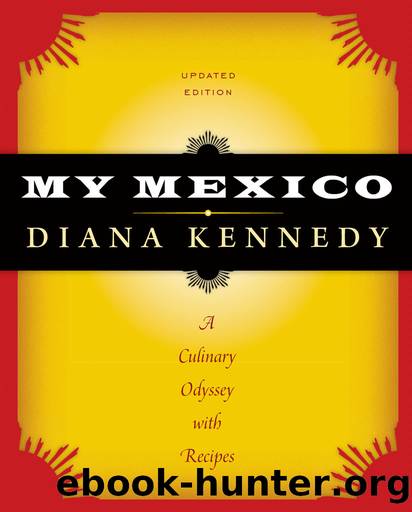My Mexico by Diana Kennedy

Author:Diana Kennedy [Kennedy, Diana]
Language: eng
Format: epub
Publisher: University of Texas Press
Published: 2013-03-14T16:00:00+00:00
* * *
*The usually benign climate with its almost constant mist-borne moisture is undergoing a change with the ruthless devastation of the ecology by deforestation of native trees; this is done to plant a type of coffee that does not, alas, require the shade of the usual protective canopy of trees.
THE GULF COAST
VERACRUZ
VERACRUZ IS THE RICHEST STATE IN MEXICO. ITS coastline extends for over five hundred miles along the Gulf of Mexico. Much of the land is flat coastal plain with sharp incursions into the eastern slopes of the mountainous mass of central Mexico and the tail of the Sierra Madre Oriental in the northern part of the state. It has broad rivers, tropical forest, and fertile lands producing sugarcane, citrus fruits, pineapple, and mangoes among many others, and excellent coffee in the higher lands. It has petroleum in the south and extensive cattle ranching. Because of the diversity of its topography and historical and cultural influencesâSpanish, Totonacs in the north, Popolucas in the south, and groups of African descent nearer the port, among othersâthe cuisine, or rather cuisines, of Veracruz are rightly considered among the richest in Mexico.
Sadly, because of this wealth, its natural resources have been pillaged: forests stripped of valuable hardwoods and left in devastating conditions, its rivers and land polluted, mostly by paper and sugar mills. There has been severe deforestation by cattle ranchers (of course not the old conservative machos) who are only just beginning to accept that cattle and trees are not incompatible. One of my trips to the Isthmus through the southern part of VeracruzâAcayucan, Catemaco, and Orizabaâwas admittedly in May, the hottest, driest time of year, but for practically the whole route the land was scorched or blackened. Earlier in the year the burning off in the cane fields sends black smoke over the countryside. Later the corn stubble is burned off by farmers wanting free potash for the next yearâs crop. Added to that are the fires set off by lazy roadworkers to clean the sides of the highway, fires that are usually left uncontrolled in the spring winds. I first visited Catemaco in the early â70s. It was a cool, shady place and had a distinct air of mystery; no wonder it is considered the land of the witches. Now the hills around have been denuded, shaved clean of vegetation, mainly to plant corn or graze cattle. The valuable tropical forests around the Tuxtlasâsupposedly nature reserves and protected by lawâare gradually being eroded by timbermen, and even the famous Island of Monkeys is now in danger. I want to shout to the powers that be and the public in general: âDoes anyone care?â And to all those responsible: âWhat legacy are you leaving for your grandchildren?â (Certainly not much, if any, of the natural beauty and bounty; in their place denuded countryside, theme parks, shopping malls, and ever more gigantic parking lots?) Of course, land resources have to be utilized, but surely without such destruction. Man must learn to live in harmony with his universe.
Download
This site does not store any files on its server. We only index and link to content provided by other sites. Please contact the content providers to delete copyright contents if any and email us, we'll remove relevant links or contents immediately.
Ariel (english and spanish Text) by Sylvia Plath(522)
Juanita Fights the School Board by Gloria Velásquez(504)
Pathfinders by AL-KHALILI JIM(498)
Rebel Ideas by Matthew Syed(459)
Planting Stories: The Life of Librarian and Storyteller Pura Belpre by Denise Anika Aldamuy(430)
The Autobiography of Martin Luther King, Jr. by Unknown(380)
My Mexico by Diana Kennedy(346)
Bury Me (Willow Heights Prep Academy: The Elite Book 3) by Selena(330)
Pop 1280 (1990) by Jim Thompson(322)
101 Awesome Women Who Changed Our World by Louise Wright(317)
I Am a Girl From Africa by Elizabeth Nyamayaro(310)
Story of a Shipwrecked Sailor (Vintage International) by Gabriel GarcÍA MÁRquez(307)
Up from Slavery: An Autobiography (Annotated) by Booker T. Washington(297)
Who Was Maria Tallchief by Catherine Gourley(290)
Lives of the Artists by Kathleen Krull(266)
Young Bucks by Matt Jackson & Nick Jackson(265)
Rad Women Worldwide by Kate Schatz(255)
Counting on Katherine: How Katherine Johnson Saved Apollo 13 by Helaine Becker(254)
The Great Book of Black Heroes: 30 Fearless and Inspirational Black Men and Women that Changed History by Bill O'Neill(251)
